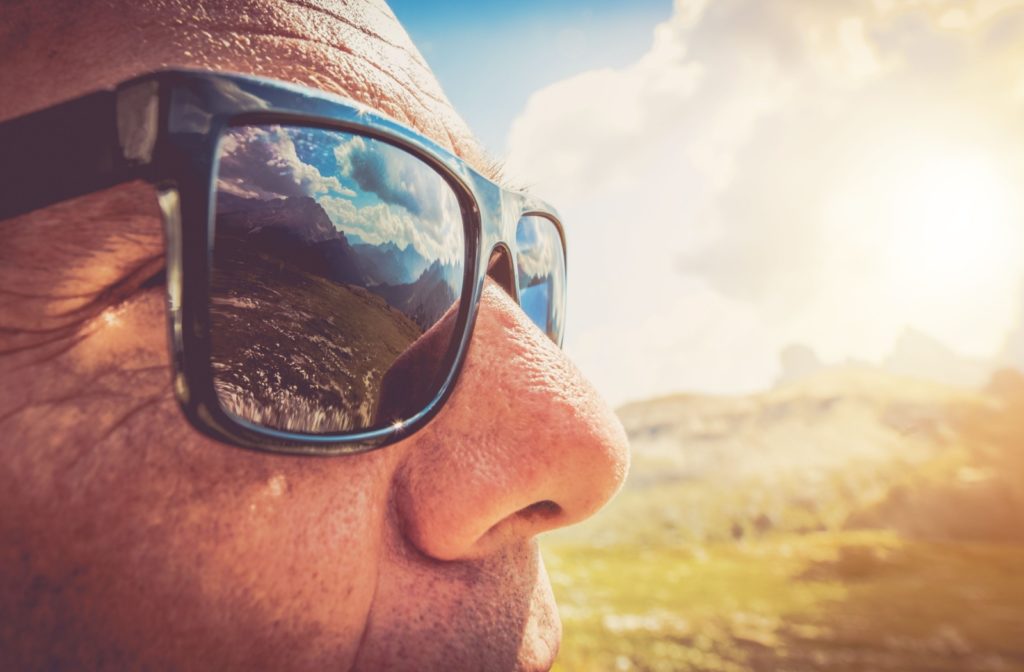Nothing beats enjoying a sunny day outside, sitting by the ocean or playing at the park. But it’s important to remember that while the sun’s warmth and light are pleasant and rejuvenating, the UV rays from the sun can also be dangerous without the right protection.
Symptoms of eye damage from the sun can include eye pain, light sensitivity, or seeing halos afterwards. The length and severity of exposure typically indicate the severity and exact symptoms you might experience.
Eye damage from the sun is typically short-term and goes away without lasting complications. But that doesn’t mean we shouldn’t take the proper precautions to prevent the chance of dealing with any serious eye diseases or conditions from sun exposure. Always wear UV-blocking sunglasses outdoors and consider other protections, such as wide-brim hats and sunscreen on your face.
Understanding UV Radiation
First, let’s break down UV radiation. The sun emits a wide range of radioactive energy, but the 3 rays we’re touching on are UVA, UVB, and UVC. Here’s the quick scoop:
- UVA rays can age us prematurely, affecting the deep layers of our skin and eyes.
- UVB rays can cause sunburn and play a significant role in the development of cataracts and other eye conditions.
- UVC rays are dangerous, but they don’t reach us because our atmosphere is a fantastic bodyguard.
Common Symptoms of Sun Damage to the Eyes
So, how do you know if those rays have been playing foul with your vision? Look out for signs of a couple of potential conditions:
Photokeratitis
Photokeratitis is a painful eye condition caused by exposure to UV rays. It’s essentially a sunburn of the cornea—the eye’s clear surface. This condition can be caused by exposure to natural sunlight, especially reflection from snow, water, or sand, and artificial sources of UV radiation like welding machines, tanning beds, or lasers, without adequate eye protection.
The severity of the symptoms usually depends on the length and intensity of the UV exposure. Fortunately, photokeratitis is generally temporary, and most people recover without permanent eye damage. Symptoms of photokeratitis include:
- Eye pain or redness
- Tearing or watery eyes
- Swelling
- Light sensitivity
- Feeling like something is in your eye
- Seeing halos
- Headaches
- Eyelid twitching
Solar Retinopathy
Solar retinopathy is a condition resulting from direct viewing of the sun’s rays, causing damage to the retina, the part of the eye responsible for vision. This damage can occur during activities like solar eclipses when individuals might be tempted to stare at the sun without proper eye protection.
The intense ultraviolet light can burn the retinal tissues, leading to symptoms such as pain in the eyes, headache, visual disturbances like blurriness or dark or yellow spots in the center of vision, light sensitivity, and sometimes loss of central vision. The severity of the symptoms and the possibility of recovery can vary, depending on the extent of the retinal damage.

Long-Term Damage from the Sun
Unlike photokeratitis or solar retinopathy, which are typically easily treatable with minimal long-term effects, sun exposure can increase your risk of developing more serious eye conditions later in life.
Cataracts
Cataracts are a common eye condition where the eye’s lens becomes progressively opaque, leading to blurry, cloudy, or dim vision. This condition is often related to aging, but there are other risk factors as well, including diabetes, smoking, prolonged exposure to sunlight, and previous eye injury or surgery.
Symptoms can include faded colors, blurry vision, halos around light, trouble with bright lights, and difficulty seeing at night.
Macular Degeneration
Macular degeneration, also known as age-related macular degeneration (AMD), is a medical condition that usually affects older adults and results in a loss of vision in the center of the visual field (the macula) because of damage to the retina. Age is typically considered the primary risk factor in AMD, but UV radiation exposure also contributes to an increased risk.
Prevention & Protection
Protecting your peepers is easier than you think:
- Say yes to sunglasses that boast 100% UV protection.
- A wide-brimmed hat isn’t just a fashion statement—it’s a shade provider for your eyes.
- Opt for UV-blocking lenses to add that extra layer of defense if you wear contact lenses.
The Importance of Regular Eye Exams
Those trendy shades and hats do a fabulous job at protection, but nothing beats a good old comprehensive eye exam. Regular check-ups can catch the sneaky onset of sun-related damage before it becomes a bigger problem.
Discuss Your Symptoms with Your Eye Doctor
Call our team at Total Vision in San Francisco, whether it’s simply time for your next eye exam or you’re experiencing some of the symptoms we discussed above after a day outside in the sun.
One of our experienced eye doctors can examine your eyes to determine whether there’s any damage or reason for long-term concern.


